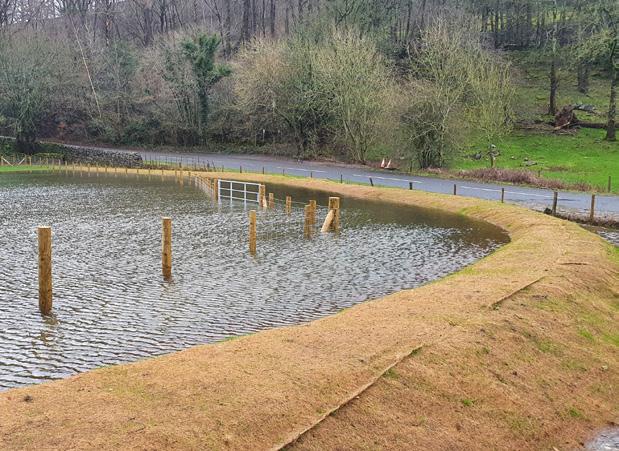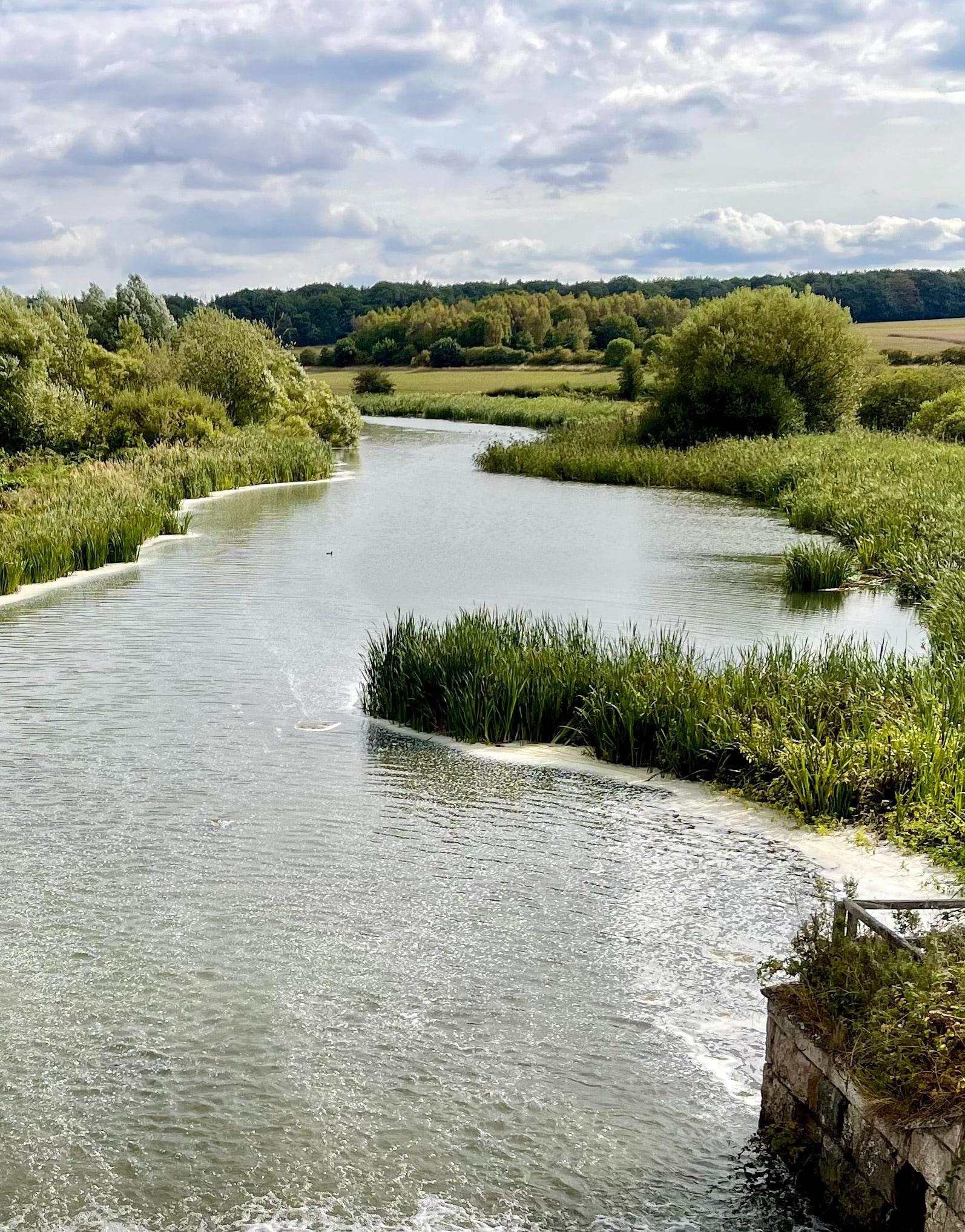Going with the flow
Policy implications of new natural flood management research

Going with the flow Policy implications of new natural flood management research
Authors
By James Elliott and Arpana Giritharan
Acknowledgements
With thanks to Dr Jonny Ritson for his guidance, also to Professor Martin Evans, Professor John Hammond and Dr Nick Chappell who led the NERC Natural Flood Management research programme.
We are grateful to the UKRI-NERC Natural Flood Management research programme for supporting this report. The programme’s research has been led by the University of Reading, University of Manchester and Lancaster University.




Green Alliance
Green Alliance is an independent think tank and charity focused on ambitious leadership for the environment. Since 1979, we have been working with the most influential leaders in business, NGOs and politics to accelerate political action and create transformative policy for a green and prosperous UK.
The Green Alliance Trust Registered charity no 1045395 Company limited by guarantee (England and Wales) no. 3037633
Published by Green Alliance March 2023


ISBN 978-1-915754-03-5
Designed by Howdy
© Green Alliance, March 2023
Text and original graphics in this work are licensed under the terms of the Creative Commons Attribution License which permits unrestricted use, provided we are credited as the original author and source. Details of the license are available at: creativecommons.org/licenses/ by/4.0. Photographic images are subject to copyright and are not covered by this license.
One of the aims of the government’s new Environmental Improvement Plan is to reduce risks to communities from flooding. One way to do this is through natural flood management (NFM). This means managing land in a way that exploits natural processes which hold water and slow its flow into streams and rivers.
NFM has played an increasingly prominent role in government strategies to reduce flood risk. But its widescale adoption and the ability to attract significant private investment to support it has been hindered by a lack of understanding of what it is, and the difficulty of quantifying its benefits when used on a large scale.
The recently completed Natural Environment Research Council (NERC) NFM research programme, carried out jointly by the Universities of Reading, Manchester and Lancaster, aimed to address these issues.
The researchers quantified the impacts of a range of interventions like peat restoration and tree planting. They found the flood reduction value of NFM in catchments between 10 and 50 km 2 to be £5-10 million over 50 years. But when other benefits of the measures, like carbon storage and habitat enhancement, were factored in, it increased this amount ten times, to between £2,630 and £6,390 a hectare a year.
Here, we outline what some of the programme’s main findings might mean for future land use policy and NFM investment.
1
What is natural flood management?
Traditionally, flood risk has been managed with hard defences, built to hold back water and move it quickly past populated areas; for example, defensive walls and banks and channelled water courses. Over the past 20 years, however, the focus has increasingly been on working with natural processes, rather than against them, to reduce flood damage.
There are a wide range of interventions that can enhance the natural function of water bodies, such as rivers and wetlands. These include increasing vegetation and managing soil, slowing the flow of water and reducing run off, and static features, such as attenuation ponds and earth bunds, which store defined amounts of water and release it slowly over time, reducing flood peaks. As well as protecting against flooding, these measures have other environmental benefits, like carbon sequestration and providing habitats for wildlife.
NFM is now routinely included in government strategies and policies.1 However, while public funding for NFM has risen, private investment has remained limited, partly due to the perception of a lack of evidence and the difficulty of quantifying the benefits of NFM when used at scale. NERC ’s NFM programme was set up to address these evidence gaps. 2
2
 Photo by Colin Jones on Unsplash
Photo by Colin Jones on Unsplash
What the new research discovered
The Natural Flood Management research programme, funded by NERC, aimed to improve understanding of the suitability and effectiveness of different measures for a range of scenarios.
The programme involved three projects which explored NFM effectiveness in different landscapes:
_ Q-NFM, led by Lancaster University, modelled the likely magnitude of NFM effects across three river catchments in Cumbria. 3
Protect, led by the University of Manchester, evaluated the benefits of upland restoration for managing flood risk, using experimental sites in the south Pennines.4

_ Landwise, led by the University of Reading, evaluated the effectiveness of land-based NFM measures to reduce risk from surface runoff, rivers and groundwater in groundwater-fed lowland catchments. 5
Measures studied included soil permeability improvements, woodland planting, in-channel leaky barriers, peat restoration, gully-blocking, enhanced hillslope storage and floodplain storage.
4
Gully restoration with additional storage to slow the flow of water, Tebay Fells, Cumbria. Image ©Nick Chappell
Below we summarise the four main lessons from this research, relevant to future policy and market development.
Interventions like peat restoration and tree planting work
NFM can reduce flood risk by holding water with static storage features, like attenuation ponds and earth bunds, and by slowing the flow of water across the land dynamically with vegetation and soil improvements.

Static storage features have been favoured because they offer a defined level of water storage, making it easy to assess their level of flood protection.
This research also quantified the benefits of NFM options that do not involve obvious water storage features. For example, the Q-NFM project quantified the benefit of rainwater evaporating from the tree canopy during extreme rainfall and the Protect project analysed the effect of slowing the flow of water across land by planting sphagnum moss on damaged peat. In an experimental micro-catchment they found that re-vegetation decreased peak flows by 27 per cent and the addition of sphagnum moss and gully blocking more than doubled this benefit.6 This demonstration of the benefits of dynamic storage,
5
“
Static storage features have been favoured because they offer a defined level of water storage.”
An earth bund holding back water in Grange-over-Sands, Cumbria. Image ©Dave Kennedy/Nick Chappell
where water is moving through the landscape at a slower pace, should enable these methods to be used more frequently in flood mitigation schemes.

NFM makes traditional flood defences more effective
While the Protect project found peat restoration significantly reduced flood peaks at hillslope scale, the Landwise and Q-NFM projects found more modest reductions when interventions were carried out at catchment scale. For example, Q-NFM modelled 20 per cent tree cover in the 70 km 2 River Kent catchment in Cumbria, finding a 2.5 per cent reduction in flood peaks.7 This is unlikely to be enough to avoid the need for traditional flood defences, but it could still be useful if it makes the difference between the traditional defences succeeding or failing.
A major difference between NFM interventions and traditional flood defences is that, once flood waters breach traditional defences, they cease to provide any benefit. But, many NFM interventions continue to reduce peak flows even in very large flood events. Even a small reduction in flood peaks provided by NFM measures can ensure traditional defences maintain a level of protection against bigger flood events.
6
“
Many NFM interventions continue to reduce peak flows even in very large flood events.”
Testing the benefits of woodland for NFM effects of wet canopy evaporation at Bessy Gill, Cumbria. Image ©Nick Chappell
Careful modelling and monitoring are needed
While interventions that improve the ability of soil to take in and store water, including woodland planting, were generally found to reduce flood risk, this was not always the case. When applied at scaled, specific local circumstances can reduce the effectiveness of the interventions and, in some cases, can marginally increase flood events. Conversely, in other cases, NFM measures can reduce river flows too much, threatening wildlife and water security.
The Landwise project modelled multiple scenarios in the 170 km 2 Pang catchment in Berkshire over a three year period, including comparing 20 per cent woodland cover. While this scenario reduced flood risk during the biggest flood peaks, there were some occasions over the three years when modelled peak flows in the NFM scenario were slightly higher (less than 1.5 per cent) than the baseline. 8 This can happen due to a ‘backwater’ effect, if lots of trees are planted next to a river in a flat area, or by increasing the speed at which water percolates through soil in areas where rivers are fed by groundwater.
In another River Thames catchment, modelling of woodland planting on all available sites highlighted the potential for reduced river flows with implications for water security and the ecology of the river.9 Careful modelling and ongoing monitoring, specific to the features of the catchment, will be needed to understand how NFM interventions will function at scale in any area.
Co-benefits can have higher value than reducing flood risk
For the more extensive NFM scenarios modelled by the projects, the average annual flood risk reduction was valued at £200,000-£400,000. Over a 50 year period the benefits were estimated at between £5 million and £10 million for catchments between 10-50km 2 . 10 In a scenario where interventions covered 1,000 hectares (eg 20 per cent of a 50 hectare catchment) this would give per hectare benefits of around £200 a year. This level of benefit is unlikely to be enough to encourage investors to fund NFM interventions on a flood risk reduction basis alone.
7
But the projects collectively found that the carbon and biodiversity benefits of NFM interventions are around ten times more valuable than the flood benefits. Across the three projects, environmental benefits were estimated at a value of between £2,630 and £6,390 per hectare per year. Over a 50 year lifetime the value of environmental benefits estimated were between £50 million and £500 million. This suggests that stacking multiple sources of funding for different benefits will be useful when making the case for NFM schemes. Green Alliance and the National Trust have previously explored how this could work.11

8
“
Stacking multiple sources of funding for different benefits will be useful in making the case for NFM schemes.”
Interventions like scrub and tree planting reduce flood risk but also capture carbon and provide wildlife habitat. Image ©Nick Chappell
 Photo by Carl Beech on Unsplash
Photo by Carl Beech on Unsplash

Policy implications
A range of policies might influence the use of NFM in England. Some are direct and obvious, such as the Environmental Improvement Plan which aims to double the number of government funded flood projects that include NFM interventions.12
Most government funding for flood risk reduction is administered through the Environment Agency and Lead Local Flood Authorities. But other government policies, where NFM is not the primary focus, could still have a significant impact on the use of NFM. From the NERC programme research we have identified three lessons in particular for policy makers:
1. More spatial targeting is needed in new farm payment schemes
Environment Land Management (ELM) schemes will soon be the main sources of funding for land management in England. Scotland and Wales are also replacing Common Agricultural Policy (CAP) payments with schemes more focused on the environment.
ELM will provide financial incentives to English farmers and landowners for NFM as well as for improving water quality, biodiversity, climate change adaptation and mitigation, air quality, coastal erosion risk mitigation, access and heritage.13
The Landscape Recovery element of ELM will fund large scale, bespoke land use projects, but the actions available via the Sustainable Farming Incentive (SFI) and Countryside Stewardship schemes are mostly designed to apply to any land without spatial targeting.
This reduces their value for NFM because, in some circumstances, catchment scale application of NFM interventions, like woodland planting, do not always reduce flood risk as intended and can have undesirable impacts on river flows. To ensure new ELM schemes are effective at reducing flood risk, and avoid causing unintentional harm, funding should be allocated to more spatially targeted elements of the Countryside Stewardship and Landscape Recovery schemes, rather than the untargeted SFI scheme.
11
2. Actions like peat restoration and woodland planting should be prioritised


Government funding, like ELM in England, as well as private finance for nature, should prioritise interventions that deliver the greatest value. Woodland and restored peatland are high value interventions to meet government goals on net zero and reverse the decline of nature. This research has shown they are also useful at reducing flood risk, which is another headline goal of the government’s Environmental Improvement Plan.
As well as enabling the stacking of multiple funding sources for NFM projects, the environmental co-benefits of interventions should be taken into account when determining whether schemes qualify for Environment Agency flood defence funding. Economic analysis suggests NFM interventions might struggle to meet the required cost benefit ratio on flood defence alone, but when environmental co-benefits are considered, they become cost effective. Particularly, the measures could help to achieve, or even exceed, the goals set in the government’s Environmental Improvement Plan and Environment Act: to restore 35,000 hectares of peat by 2025; to increase tree cover from 14.5 to 16.5 per cent in England by 2050; to restore 500,000 hectares of wildlife rich habitats by 2042; and to restore 75 per cent of water bodies to ‘good’ status.
12
“ Government funding should prioritise interventions that deliver the greatest value.”
Peatland on Kinder Scout, Peak District, in 2009 (left) and in 2019 (right) after restoration. Image ©Tim Allott
3. Planning tools need improvement to raise private investment prospects
The government is banking on new private investment to do a lot of the heavy lifting to achieve its environmental targets. It wants there to be at least £500 million of private investment a year by 2027, rising to £ 1 billion for nature recovery every year by 2030.14
NFM could be a potential market for ecosystem services, generating private payments for nature restoration.15 But, so far, it has been limited to a few projects such as the Wyre Natural Environment Investment Readiness Fund project.16
To take full advantage of the opportunities it offers, tools like the Environment Agency’s ‘Flood map for planning’ should integrate evidence showing the benefits of NFM schemes. Businesses use tools like these when making decisions about investment in flood protection.
Previous Green Alliance research found that it is often difficult for businesses, like infrastructure operators, to demonstrate the benefits of NFM robustly enough to move investment decisions away from traditional options, even in circumstances when the NFM solution might reduce costs.17 Accurate quantification of the benefits of a range of NFM interventions, using officially sanctioned tools, should help to support the investment case.
13
“
NFM could be a potential market for ecosystem services.”
 Photo by Daniel Sessler on Unsplash
Photo by Daniel Sessler on Unsplash
Endnotes
1 See for example: Environment Agency, 2020, National flood and coastal erosion risk management strategy for England; and HM Government, 2020, Flood and coastal erosion risk management policy statement
2 For more information see: research.reading.ac.uk/nerc-nfm/
3 For more information see: www.lancaster.ac.uk/lec/sites/qnfm/
4 For more information see: protectnfm.com/
5 For more information see: research.reading.ac.uk/nerc-nfm/landwise-nfm/
6 E Shuttleworth, et al, 2019, ‘Restoration of blanket peat moorland delays stormflow from hillslopes and reduces peak discharge’, Journal of hydrology X; and a forthcoming publication from the Protect NFM project
7 N Chappell, et al, paper in preparation which will be available at www.lancaster.ac.uk/lec/sites/qnfm/
8 NERC NFM programme calculations, publication forthcoming
9 S Collins, et al, 2023, ‘Modelling the effectiveness of land-based natural flood management in a large, permeable catchment’, Journal of flood risk management
10 JBA Consulting, 2023, NERC pan-programme NFM economics analysis: final draft (unpublished report)
11 See for example: Green Alliance and National Trust, 2019, New routes to decarbonise land use with Natural Infrastructure Schemes; and Green Alliance, National Trust and 3Keel, Building local markets for sustainable land management with the Eden Model: a toolkit for practitioners
12 HM Government, 2023, Environmental Improvement Plan 2023
13 Department for Environment, Food and Rural Affairs, 6 January 2022, policy paper, Environmental land management schemes: outcomes
14 HM Government, 2023, op cit
15 See, for example: Green Alliance and National Trust, 2016, New markets for land and nature: how Natural Infrastructure Schemes could pay for a better environment.
16 The Rivers Trust, ’ Wyre NFM Investment Readiness Project’, theriverstrust. org/our-work/our-projects/wyre-nfm-investment-readiness-project
17 Green Alliance and National Trust, 2018, Funding nature’s recovery: how new public spending can unlock private investment
15
The NERC Natural Flood Management research programme projects
Led by the University of Reading, this project, based in parts of the Thames catchment, evaluated the effectiveness of realistic and scalable land-based NFM measures to reduce the risk from flooding from surface runoff, rivers and groundwater in lowland catchments. It studied measures like crop choice, tillage practices and tree planting, and sought to fill gaps in knowledge that make it hard to include these NFM measures in flood risk mitigation schemes.
For more information see research.reading.ac.uk/nerc-nfm/landwise-nfm/
Led by Lancaster University, this project quantified the likely effectiveness of NFM measures for mitigating flood risk at small to large catchment scales. It studied measures, including sward lifting and leaky bunds, hedgerow and wall restoration, leaky dams in peatland gullies and headwater channels, tree planting and floodplain reconnection, to address gaps in evidence on how NFM measures work to reduce peak flow for communities at risk of flooding. It was based in three large Cumbrian catchments, Kent, Derwent and Eden, but with experimental work elsewhere in the UK.
For more information see www.lancaster.ac.uk/lec/sites/qnfm/
Led by the University of Manchester, this work, based in upland catchments with blanket peat cover in the Peak District, aimed to demonstrate that upland moorland restoration is a low cost way to reduce flood risk in vulnerable rural communities, and to optimise multi-benefit restoration work for NFM. It collaborated with the Moors for the Future Partnership and the Environment Agency to assess the impact of various forms of moorland restoration, including gully blocking, sphagnum moss reintroduction and upland woodland establishment, on hillslope runoff and channel flow.
For more information see protectnfm.com/
16
NFM LANDWISE Q-NFM NFM PROTECT
17
Green Alliance
18th Floor
Millbank Tower
21-24 Millbank
London SW1P 4QP
020 7233 7433
ga@green-alliance.org.uk
www.green-alliance.org.uk
@GreenAllianceUK
blog: www.greenallianceblog.org.uk







 Photo by Colin Jones on Unsplash
Photo by Colin Jones on Unsplash





 Photo by Carl Beech on Unsplash
Photo by Carl Beech on Unsplash



 Photo by Daniel Sessler on Unsplash
Photo by Daniel Sessler on Unsplash